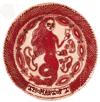- slipware
-
/slip"wair'/, n.pottery decorated with slip.[1905-10; SLIP3 + WARE1]
* * *
The technique was originally used to cover defects in body colour, but later evolved into decorative techniques such as sgraffito, carving, painting, trailing, marbling, and inlay. In sgraffito a pattern is incised through the slip to reveal the different body colour underneath. The Staffordshire potters in 17th-century Britain were famous for the decorative figures, flowers, and patterns they created by using dotted and trailed slip. English slipware dish by Thomas Toft of northern Staffordshire, c. 1680; in the Victoria and Albert ...By courtesy of the Victoria and Albert Museum, London
English slipware dish by Thomas Toft of northern Staffordshire, c. 1680; in the Victoria and Albert ...By courtesy of the Victoria and Albert Museum, London* * *
▪ potterypottery that has been treated, in one way or another, with semiliquid clay, or slip, sometimes called barbotine. Originally, defects of body colour suggested the use of slip, either white or coloured, as a wash over the vessel before firing. The decorative uses of slip later evolved include sgraffito and carving, painting, trailing, marbling, and inlay. In sgraffito decoration (used, for example, in Islāmic pottery), a pattern is incised through the slip, revealing the different body colour beneath. In the related slip carving (practiced by Islāmic potters and by Chinese potters of the Sung dynasty [960–1279]), the coating of slip, which is thicker, is carved out with a knife, leaving a slightly raised design. Slip painting was widely used in ancient Egyptian pottery, in which animal and scenic motifs are painted in white slip on a red body, and in North American Indian wares. Another form of slip decoration is the piping on of trails of slip in the manner of cake icing, so that a design is achieved in lines of colour (often white) contrasting with the body of the vessel. Further molding of the applied slip may be carried out or small blobs of slip dropped on and then molded or stamped with a raspberry, rosette, or other shape.Dotted and trailed slip decoration was probably never so well executed as in 17th-century England, where the north Staffordshire (Staffordshire ware) potters and those of Wrotham, Kent, depicted human and animal figures, stylized flowers, and fluid linear patterns. The technique demanded great dexterity and control, and some of its happiest effects were in a naively calligraphic treatment of figures and writing.A marbled effect was sometimes achieved (as in Chinese pottery of the T'ang dynasty [618–907]) by mingling, with a comb, slips of contrasting colours after they had been applied to the vessel. Slip has also been used by the Koreans for their inlay technique known as mishima: (punch'ŏng pottery) designs were first incised into the clay, and the incisions were then filled with black-and-white slip.* * *
Universalium. 2010.
